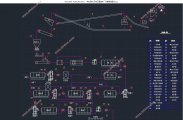30万吨/年石墨原矿选矿厂工艺流程设计(含CAD图)(任务书,开题报告,设计说明书15000字,CAD图纸5张)
摘 要
选别石墨的方法有重选、电选、浮选这三种方法,浮选是最常用的方法。对国内外浮选石墨的工艺进行了解,对浮选设备、浮选药剂的一些工艺进行研究研究。最后根据石墨性质以及所给的条件查阅相关资料,确定了30万吨/年石墨选矿厂的工艺流程。选矿厂的原矿品位α=3.83%,精矿品位β=91.91%,精矿总回收率ε=85.12%,对石墨精矿选矿生产线进行设计。根据这些数据进行计算,推出原矿的处理量,同时结合工作制度来确定破碎车间和磨浮车间日处理量。根据原矿和破碎后的最大粒度,计算破碎比,最终确定选用两段一闭路的破碎流程,筛分之后细粒度的矿物要送入入磨浮车间进行磨矿浮选。粗磨之后,再进行粗选,如此重复选别五次。根据每天的处理量,计算各段的矿量以及水量和矿浆量,画出数质量流程图和水质量流程图,根据它们以及磨矿细度,产率等各段选矿对产物的要求,来对磨机的磨矿时间和浮选机的浮选时间判断,对设备类型进行选择;根据各段的处理量,对各设备的型号和规格进行选择。
关键词:选矿厂设计;石墨选矿;生产流程;设备选型
Abstract
In this paper, the method of flotation of graphite made brief introduction, gravity separation, electrostatic separation, flotation of the three methods, of course, now used up is flotation. The technology of flotation graphite at home and abroad is introduced, and some process of flotation equipment, flotation reagents and the protection of graphite chips. Refer to the relevant information according to the properties of the graphite and the conditions given, the technological process of the 10,000 tons / year graphite concentrate concentrator. The ore grade taste alpha is 3.83%, the concentrate taste beta is 91.91%, the total recovery rate of epsilon is 85.12%, and design of mineral processing production line of graphite concentrate.Launch the handling capacity of ore based on these data, combined with the concentrator of the system and determining the amount of daily processing of crushing and grinding and flotation workshop for workshop. First according to the maximum particle size of the ore, and after the crushing of the maximum particle size calculated broken ratio, determine the selection of three sections of a closed-circuit crushing process, the screening fine-grained minerals into grinding and flotation workshop, grinding flotation. Enter the floating mill workshop first minerals for coarse grinding, coarse grinding after roughing, after regrinding, a total of five times. According to the daily handling capacity, sections of the quantity and quality, the water quantity and pulp volume was calculated and draw the flow chart of the number of quality and the quality of the water flow chart, according to them and segment processing product requirements, such as grinding fineness and yield of the mill grinding ore time as well as the flotation machine flotation time to judge, and the equipment type selection; according to the processing capacity of the paragraphs, the equipment models and specifications.
Keywords: mineral processing design; graphite ore dressing; production process; equipment selection.
2.1 选矿厂的规模及服务年限
规模:日处理1000.00吨;
选定指标:①磨矿细度为:-100目占51.79%
②原矿最大粒度Dmax=500mm
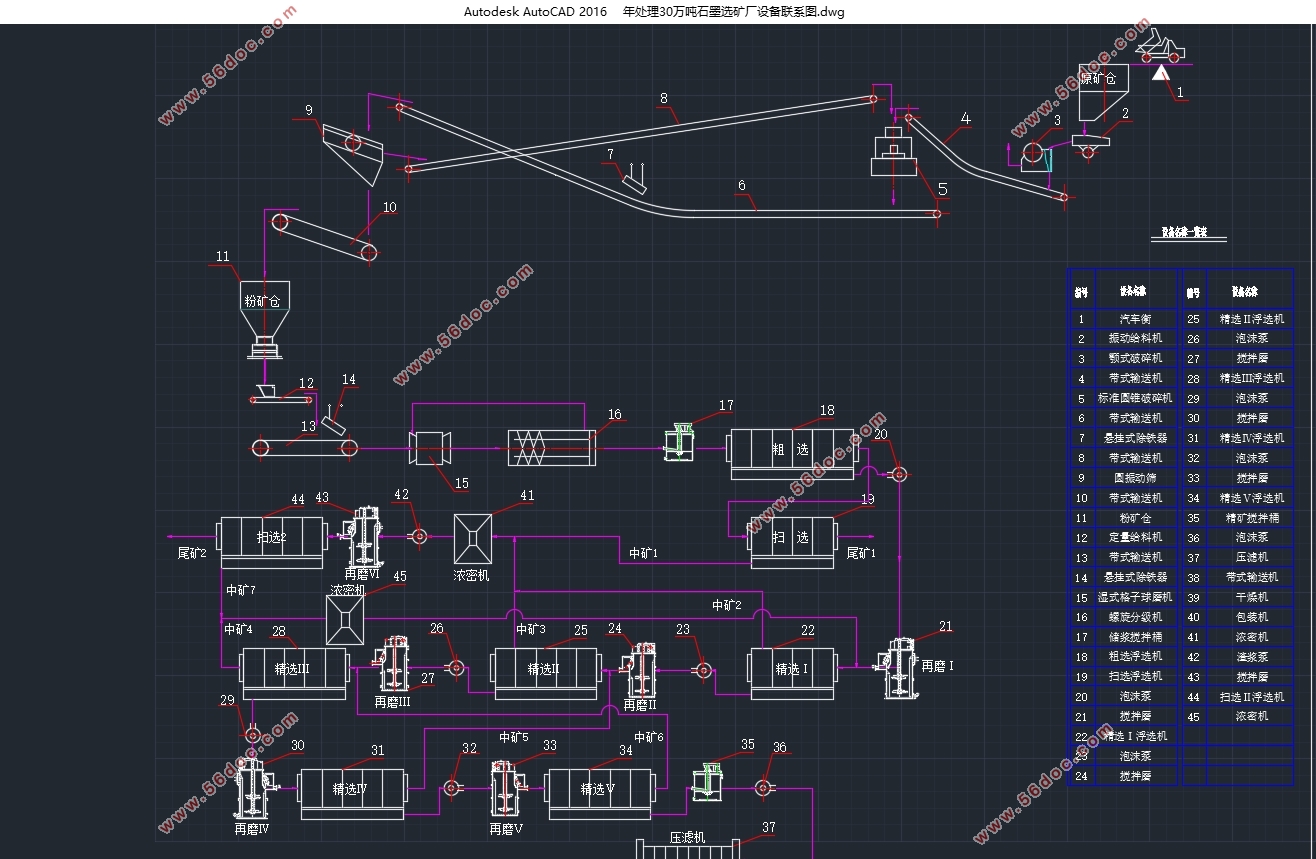
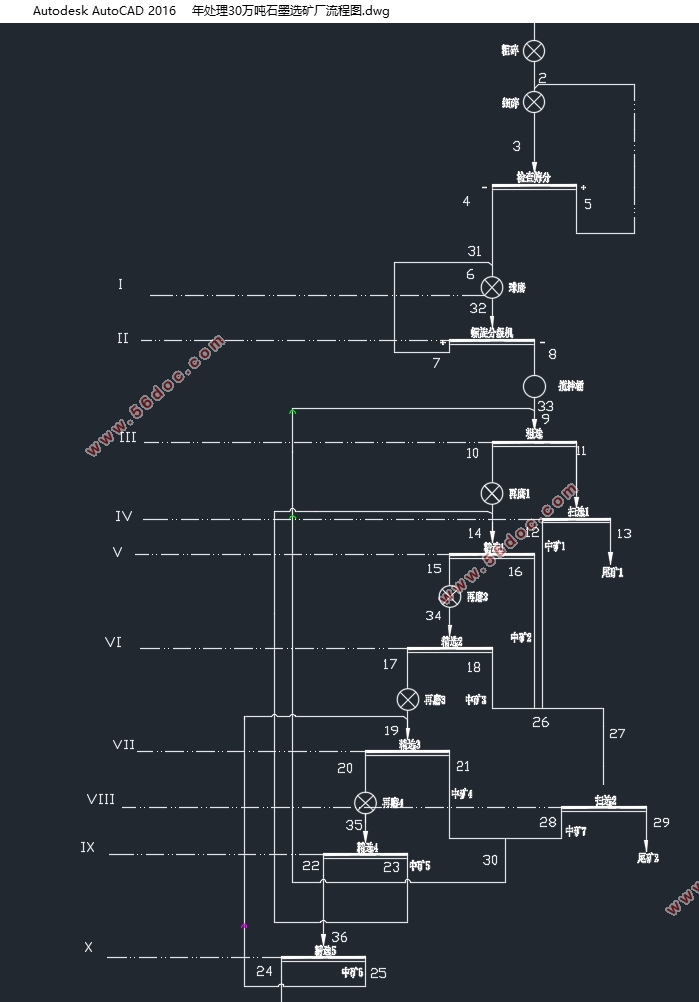
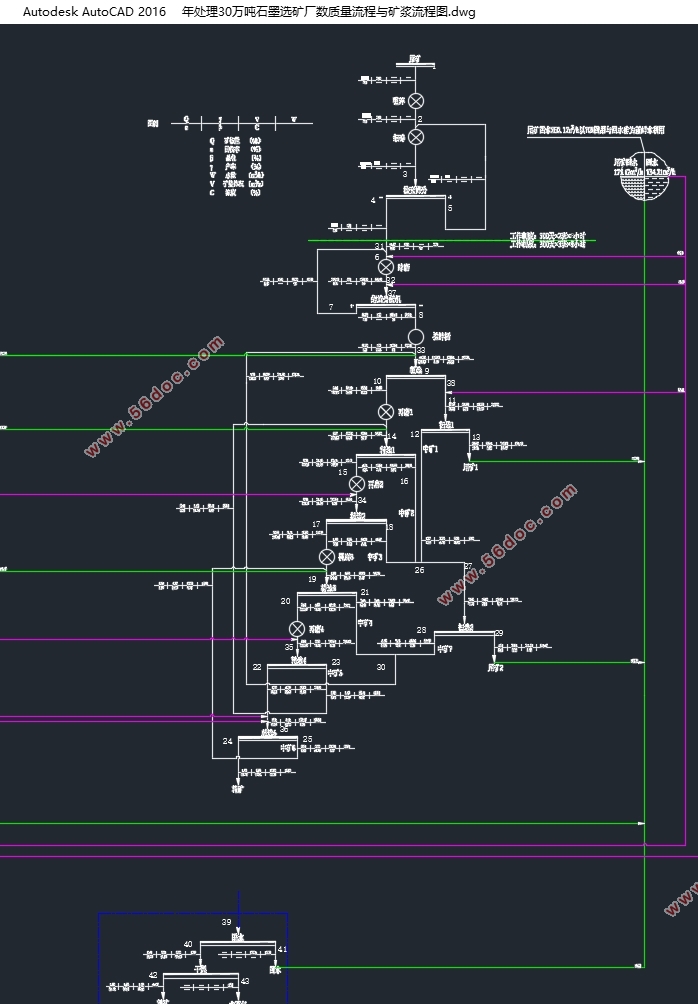
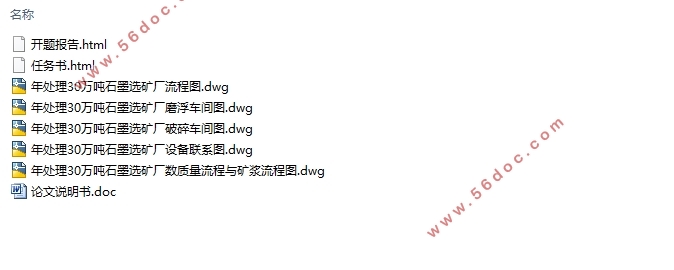
目录
摘 要 I
第一章 绪论 1
1.1 石墨选矿的方法 1
1.2 石墨选矿厂工艺流程 1
第二章 选矿厂的规模与工作制度 3
2.1 选矿厂的规模及服务年限 3
2.2 选矿厂工作制度与设备作业率 3
2.3 选矿厂小时处理矿量 3
第三章 选矿工艺流程的选择与计算 4
3.1 破碎筛分流程的选择与计算 4
3.1.1破碎筛分流程的选择确定 4
3.1.2破碎筛分流程的计算: 4
3.1.3破碎筛分流程的计算 5
3.2磨矿分级的计算 6
3.3.1据试验报告选定原始指标数量和具体的指标。 8
3.3.2计算各产物的产率及品位 8
3.3.3计算各产物的产量 10
3.3.4计算各产物的回收率 12
3.3.5选别数质量流程图 13
3.3.6选别数质量平衡表 14
3.4矿浆流程的计算 19
3.4.1磨矿流程 19
3.4.2浮选流程 19
3.4.3选别数质量流程图 24
3.4.4选别数质量平衡表 25
3.4.5选矿厂水量平衡表 29
第四章 主要工艺设备的选择与计算 30
4.1 破碎筛分车间设备的选择与计算 30
4.1.1 一段粗碎设备的选择与计算 30
4.1.2 二段中碎破碎机的选择与计算 31
4.2 筛分设备的选择与计算 33
4.3 磨浮车间设备的选择与计算 35
4.3.1 磨矿设备 35
4.3.2分级设备 36
4.3.3 石墨矿再磨设备的选型与计算 37
4.3.4 浮选设备的选型与计算 39
4.4 精矿脱水设备的选择与计算 42
4.4.1 浓缩机的计算 42
4.4.2 过滤机的计算 43
4.4.3 干燥机的计算 44
第五章 辅助设备的选择与计算 45
5.1 矿仓 45
5.2 给料机 46
5.2.1 粗碎机给料机 46
5.2.2.磨矿机给料机 46
5.3 皮带运输机的选型和计算 47
5.3.1胶带宽度的计算 47
5.3.2按最大块度校核 47
5.3.3传动滚筒功率 47
5.3.4计算电动机功率 48
5.4 储矿浆搅拌槽的选择计算 48
5.5 定量给料机 48
5.6 泵的选择计算 49
5.6.1 尾矿输送泵(1#泵)的选择与计算 49
5.6.2 精矿压滤机进料泵(2#泵)的选择与计算 49
5.6.3 供水水泵的选择与计算 52
结论 55
参考文献 56
致 谢 57
|
